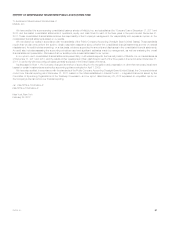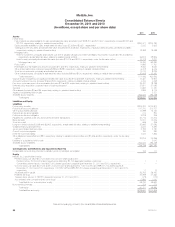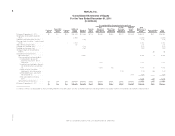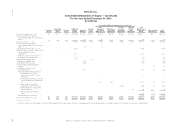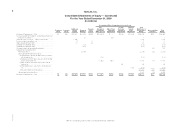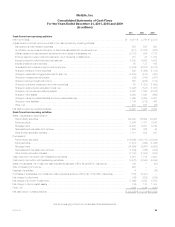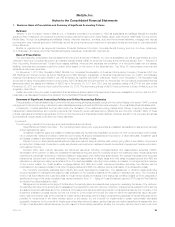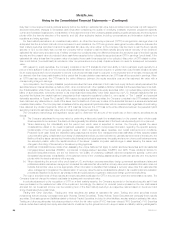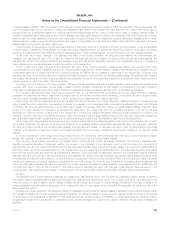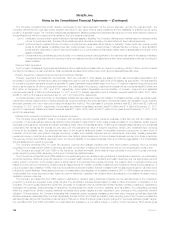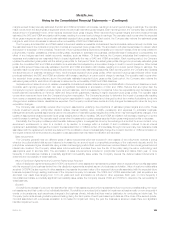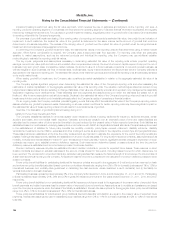MetLife 2011 Annual Report Download - page 99
Download and view the complete annual report
Please find page 99 of the 2011 MetLife annual report below. You can navigate through the pages in the report by either clicking on the pages listed below, or by using the keyword search tool below to find specific information within the annual report.MetLife, Inc.
Notes to the Consolidated Financial Statements
1. Business, Basis of Presentation and Summary of Significant Accounting Policies
Business
“MetLife” or the “Company” refers to MetLife, Inc., a Delaware corporation incorporated in 1999, its subsidiaries and affiliates. MetLife is a leading
global provider of insurance, annuities and employee benefit programs throughout the United States, Japan, Latin America, Asia Pacific, Europe and the
Middle East. Through its subsidiaries and affiliates, MetLife offers life insurance, annuities, auto and homeowners insurance, mortgage and deposit
products and other financial services to individuals, as well as group insurance and retirement & savings products and services to corporations and
other institutions.
MetLife is organized into six segments: Insurance Products, Retirement Products, Corporate Benefit Funding and Auto & Home (collectively,
“U.S. Business”), and Japan and Other International Regions (collectively, “International”). See Note 22.
Basis of Presentation
The accompanying consolidated financial statements include the accounts of MetLife, Inc. and its subsidiaries, as well as partnerships and joint
ventures in which the Company has control, and variable interest entities (“VIEs”) for which the Company is the primary beneficiary. See “— Adoption of
New Accounting Pronouncements.” Closed block assets, liabilities, revenues and expenses are combined on a line-by-line basis with the assets,
liabilities, revenues and expenses outside the closed block based on the nature of the particular item. See Note 10. Intercompany accounts and
transactions have been eliminated.
On November 1, 2010 (the “Acquisition Date”), MetLife, Inc. completed the acquisition of American Life Insurance Company (“American Life”) from
AM Holdings LLC (formerly known as ALICO Holdings LLC) (“AM Holdings”), a subsidiary of American International Group, Inc. (“AIG”), and Delaware
American Life Insurance Company (“DelAm”) from AIG (American Life, together with DelAm, collectively, “ALICO”) (the “Acquisition”). The Acquisition was
accounted for using the acquisition method of accounting. ALICO’s fiscal year-end is November 30. Accordingly, the Company’s consolidated financial
statements reflect the assets and liabilities of ALICO as of November 30, 2011 and 2010, and the operating results of ALICO for the year ended
November 30, 2011 and the one month ended November 30, 2010. The accounting policies of ALICO were conformed to those of MetLife upon the
Acquisition. See Note 2.
Certain amounts in the prior years’ consolidated financial statements and related footnotes thereto have been reclassified to conform with the 2011
presentation as discussed throughout the Notes to the Consolidated Financial Statements.
Summary of Significant Accounting Policies and Critical Accounting Estimates
The preparation of financial statements in conformity with accounting principles generally accepted in the United States of America (“GAAP”) requires
management to adopt accounting policies and make estimates and assumptions that affect amounts reported in the consolidated financial statements.
A description of critical estimates is incorporated within the discussion of the related accounting policies which follows. In applying these policies,
management makes subjective and complex judgments that frequently require estimates about matters that are inherently uncertain. Many of these
policies, estimates and related judgments are common in the insurance and financial services industries; others are specific to the Company’s business
and operations. Actual results could differ from these estimates.
Investments
The accounting policies for the Company’s principal investments are as follows:
Fixed Maturity and Equity Securities. The Company’s fixed maturity and equity securities are classified as available-for-sale and are reported
at their estimated fair value.
Unrealized investment gains and losses on these securities are recorded as a separate component of other comprehensive income (loss),
net of policyholder-related amounts and deferred income taxes. All security transactions are recorded on a trade date basis. Investment gains
and losses on sales of securities are determined on a specific identification basis.
Interest income on fixed maturity securities is recorded when earned using an effective yield method giving effect to amortization of premiums
and accretion of discounts. Dividends on equity securities are recorded when declared. Interest, dividends and prepayment fees are recorded in
net investment income.
Included within fixed maturity securities are structured securities including mortgage-backed and asset-backed securities (“ABS”).
Amortization of the premium or discount considers the estimated timing and amount of prepayments of the underlying loans. Actual prepayment
experience is periodically reviewed and effective yields are recalculated when differences arise between the originally anticipated and the actual
prepayments received and currently anticipated. Prepayment assumptions for single class and multi-class mortgage-backed and ABS are
estimated by management using inputs obtained from third-party specialists, including broker-dealers, and based on management’s knowledge
of the current market. For credit-sensitive mortgage-backed and ABS and certain prepayment-sensitive securities, the effective yield is
recalculated on a prospective basis. For all other mortgage-backed and ABS, the effective yield is recalculated on a retrospective basis.
The Company periodically evaluates fixed maturity and equity securities for impairment. The assessment of whether impairments have
occurred is based on management’s case-by-case evaluation of the underlying reasons for the decline in estimated fair value. The Company’s
review of its fixed maturity and equity securities for impairments includes an analysis of the total gross unrealized losses by three categories of
severity and/or age of the gross unrealized loss, as summarized in Note 3 “— Aging of Gross Unrealized Loss and OTTI Loss for Fixed Maturity
and Equity Securities Available-for-Sale.”
Management considers a wide range of factors about the security issuer and uses its best judgment in evaluating the cause of the decline in
the estimated fair value of the security and in assessing the prospects for near-term recovery. Inherent in management’s evaluation of the security
are assumptions and estimates about the operations of the issuer and its future earnings potential. Considerations used by the Company in the
impairment evaluation process include, but are not limited to: (i) the length of time and the extent to which the estimated fair value has been
below cost or amortized cost; (ii) the potential for impairments of securities when the issuer is experiencing significant financial difficulties; (iii) the
potential for impairments in an entire industry sector or sub-sector; (iv) the potential for impairments in certain economically depressed
geographic locations; (v) the potential for impairments of securities where the issuer, series of issuers or industry has suffered a catastrophic type
of loss or has exhausted natural resources; (vi) with respect to fixed maturity securities, whether the Company has the intent to sell or will more
MetLife, Inc. 95




